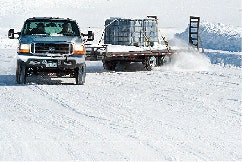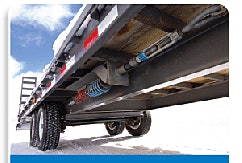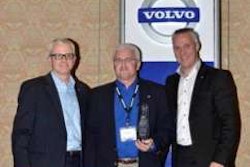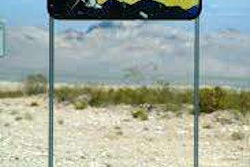A school for your pickup+equipment trailer winter drivers
by Larry Walton, Associate Editor, ProPickup magazine

Most of the dirt movers we met on a tire test trip to Steamboat Springs, Colo., keep working until winter stops them. Agencies of course have snow control reponsibilites. So here, like any other place that is white and icy in the cold months, compact track loaders, backhoes, skid steers, patchers, plow blades, various attachments and other equipment have to be moved on trailers behind pickups.
So I was inspired to take a day of “snow tow” training at the Bridgestone Winter Driving School (BWDS) just outside of town to be better equipped to handle icy trailer towing.
Most of the winter driving tips and techniques I’ve learned on previous winter training classes at BWDS apply: Make sure the vehicle is in good working order; use snow tires; slow down; and do all your braking and accelerating in a straight line.
But the standard BWDS driving classes don’t teach one important thing: what to do during a “trailer event.” That’s where the snow-tow trailer towing class pays off big for a driver who’ll haul a trailer behing a pickup in deep winter.
I found this out the first time my instructor purposefully jackknifed the trailer behind the school’s specially equipped F-250 4×4 as we approached a 90-degree downhill right-hander on the trailering road course.
Instinctively, I went for a counter steer born of racing on mud tracks. Wrong.
 The Bridgestone Winter Driving School designed a special trailer for snow-tow training behind the school’s F-250 4×4 diesel. The truck has a manual brake controller that is operated by the instructor from the passenger’s seat.
The Bridgestone Winter Driving School designed a special trailer for snow-tow training behind the school’s F-250 4×4 diesel. The truck has a manual brake controller that is operated by the instructor from the passenger’s seat.The trailer, loaded with several thousand pounds of water in a tank above the axles, is equipped with stabilizing cables on giant coil springs attached between the tongue and mid-frame. The system was designed by the school to limit the amount of jackknife on the pickup-trailer combination. This custom setup saves the tow vehicle from damage and helps students learn corrective driving skills quicker. –LW
My corrective steering action only served to fold the pickup-trailer combination even further.
Once I had the trailer back inline and the truck stopped, my instructor walked me through the correct response to such a trailer event: Accelerate to get the trailer back in line and then brake to regain control.
He also pointed out getting around corners with a trailer in icy conditions is best done by “boxing off” or “V-ing off” the corners. In other words, brake in a straight line before entering the corner, get all of the steering done at once while the trailer is responding, then accelerate out of the corner in a straight line.
We spent several hours going around the course again and again while he locked the trailer’s brakes and I practiced the cornering and recovery techniques. It wasn’t long before I could keep the trailer under control no matter how hard he tried to make it jackknife. I passed.
The beauty of training on an ice track is learning to control of pickup/trailer combination under safe, slow, controlled – but real – conditions with an expert in the passenger’s seat.
NOTE: There are also courses for drivers of trucks and cars without trailers.
Check out the school at www.winterdrive.com. Trailer classes set up by arrangement – email [email protected].














